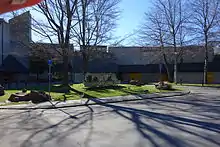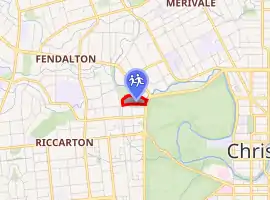Christchurch Girls' High School
Christchurch Girls' High School in Christchurch, New Zealand, was established in 1877 and is the second oldest girls-only secondary school in the country, after Otago Girls' High School.[3]
| Christchurch Girls' High School | |
|---|---|
 Christchurch Girls' High School | |
| Address | |

| |
10 Matai Street 8011 New Zealand | |
| Coordinates | 43.5249°S 172.6109°E |
| Information | |
| Type | State Single Sex Girls' Secondary (Year 9–13) with boarding facilities. |
| Motto | Sapientia et Veritas "Wisdom and Truth" |
| Established | 1877 |
| Ministry of Education Institution no. | 328 |
| Principal | Christine O'Neill (from 2019) |
| School roll | 1261[1] (March 2020) |
| Socio-economic decile | 9Q[2] |
| Website | www |
History
Christchurch Girls' High School was established in 1877, four years before Christchurch Boys' High School. The first headmistress was Mrs. Georgiana Ingle (a daughter of Richard Deodatus Poulett-Harris and half-sister of Lily Poulett-Harris). The second principal Helen Connon (later Helen Macmillan Brown) is better known as she was the first woman in any British university to gain an Honours degree.
The school's original building on Cranmer Square, which was renamed the Cranmer Centre, features prominently in the 1994 film Heavenly Creatures based on the 1954 Parker–Hulme murder case involving two students.
The school featured in national and international news in 1972 when two students led a "walkout"[4][5] from school assembly to protest the inclusion of religion in school morning assemblies. At the time, schools in New Zealand were supposed to be secular but this was largely ignored and students were usually told to bring a note from their parents if they wanted to opt out of the religious component of school assemblies.
In June 2020, students complained that posters they had put up promoting the Black Lives Matter movement were removed without adequate explanation. Students reported that some staff had said the posters could damage the walls, but that other posters were allowed to remain, while the staff member who took the posters down reportedly said it was because "all lives matter". The incident followed similar complaints at two other New Zealand schools, where students had alleged racist motivations for removing posters. Prime MInister Jacinda Ardern, commenting on the issues across the three schools, said that the matters were for schools to deal with, but she did not discourage the students' actions, while Massey University sociologist Paul Spoonley said it was censorship and appeared to be "institutional racism – racism that has come from the school itself".[6]
Present day
Christchurch Girls' High School, known to many as Girls' High or CGHS, provides boarding facilities for 95 students from years 9 to 13 at Acland House, located 20–30 minutes walk away from school.
The school stands by the Avon River, on a site it has occupied since 1986. Previously, the area was occupied by a mill that was first built in 1861 by William Derisley Wood, which became known as the Riccarton Mill.[7]
The February 2011 Christchurch earthquake had a large impact on the school: it caused extensive damage to the current site;[8] the old Cranmer Centre site was damaged so badly that it was later demolished – and the school's principal at the time, Prue Taylor, lost her husband Brian in the CTV Building collapse.[9]
CGHS was the first school to go into lock down during the Christchurch mosque shootings at approximately 1:52pm on 15 March 2019.
The current principal is Christine O'Neill, who started the role in July 2019. Pauline Duthie, previous principal of the school, held the role from 2014 to March 2019 and left to be a principal at Columba College in Dunedin.[10]
Notable alumnae
- Ursula Bethell (1874–1945), poet and social worker[11]
- Alice Candy (1888–1977), academic and second woman lecturer at Canterbury College[12]
- Elsie Dohrmann (1875–1909), temperance campaigner[13]
- Eileen Fairbairn (1893–1981), teacher and geographer[14]
- Marama Fox, politician and co-leader of the Māori Party[15]
- Helen Gibson (1868–1938), founder of Rangi Ruru Girls' School[16]
- Mary Gibson (1864–1929), Principal of CGHS for thirty years[16]
- Stella Henderson (1871–1926), first woman Parliamentary reporter for a major New Zealand newspaper[17]
- Edith Searle Grossmann (1863–1931), writer and teacher[18]
- Elizabeth Herriott (1882–1936), academic and first woman lecturer at Canterbury College[19]
- Margaret Lorimer (1866–1954), mountaineer and Principal of Nelson College for Girls for twenty years[20]
- Pauline Parker (born 1938), convicted murderer[21]
- Anne Perry (born 1938 as Juliet Hulme), English author and convicted murderer[21]
- Christabel Robinson (1898–1988)[22]
- Myrtle Simpson (1905–1981)[23]
- Gwen Somerset (1894–1988), adult educator and writer
- Joyce Watson (1918–2015)[24]
- Fay Weldon, (born 1931), English author[25]
- Ivy Fife (1905–1976), painter
Notable staff
- Catherine Alexander (1863–1928), first known woman to publish a paper in the Royal Society Te Apārangi's Transactions[26]
- Kate Edger (1857–1935), first woman university graduate in New Zealand[27]
- Emily Foster (1842–1897)[13]
- Christina Henderson (1861–1953)[28]
- Leila Hurle (1901–1989)[29]
- Stephanie Young (1890–1983)[30]
- Elsie Low (1875–1909)[31]
References
- "New Zealand Schools Directory". New Zealand Ministry of Education. Retrieved 26 April 2020.
- "Decile Change 2014 to 2015 for State & State Integrated Schools". Ministry of Education. Retrieved 12 February 2015.
- Lovell-Smith, Melanie (8 December 2001). "Cranmer Centre (Former Christchurch Girls High)". New Zealand Historic Places Trust Pouhere Taonga. Archived from the original on 15 June 2012. Retrieved 20 May 2011.
- Sally Varnham. "'Getting Rid of Troublemakers': The Right to Education and School Safety – Individual Student vs School Community" (PDF). Austlii.edu.au. Retrieved 4 February 2016.
- "Third school's students complain over Black Lives Matter poster removal". RNZ. 10 June 2020. Retrieved 10 June 2020.
- "The Riccarton Mill before the business was transferred to Addington". Christchurch City Libraries. Retrieved 20 May 2011.
- Structural Inspection Report – 24 June 2011
- Williams, David; Young, Rachel (10 February 2012). "CTV building's flaws went unnoticed". The Press. Retrieved 26 October 2013.
- Loughrey, David (29 November 2018). "New principal for Columba College". Otago Daily Times.
- Whiteford, Peter (June 2008). "Ursula Bethell, 1874–1945". Kōtare: New Zealand Notes & Queries. 7 (3): 90. doi:10.26686/knznq.v7i3.707. Retrieved 14 December 2020.
- Gardner, W. J. "Alice Muriel Flora Candy". Dictionary of New Zealand Biography. Ministry for Culture and Heritage. Retrieved 23 April 2017.
- Taonga, New Zealand Ministry for Culture and Heritage Te Manatu. "Foster, Emily Sophia". www.teara.govt.nz. Retrieved 15 May 2016.
- Taonga, New Zealand Ministry for Culture and Heritage Te Manatu. "Fairbairn, Eileen". www.teara.govt.nz. Retrieved 10 November 2015.
- "I wanted to know what they were saying". E-Tangata – A Māori and Pasifika Sunday magazine. 11 April 2015. Retrieved 15 May 2016.
- Taonga, New Zealand Ministry for Culture and Heritage Te Manatu. "Gibson, Helena Fannie and Gibson, Mary Victoria". www.teara.govt.nz. Retrieved 13 November 2015.
- Taonga, New Zealand Ministry for Culture and Heritage Te Manatu. "Henderson, Stella May". www.teara.govt.nz. Retrieved 9 June 2016.
- Taonga, New Zealand Ministry for Culture and Heritage Te Manatu. "Grossmann, Edith Searle". www.teara.govt.nz. Retrieved 6 February 2016.
- Thomson, A.D. "Some Pioneer Women Graduates in Botany from Canterbury University College" (PDF). Centre for Studies on New Zealand Science History. Archived from the original (PDF) on 14 February 2016. Retrieved 8 February 2016.
- Taonga, New Zealand Ministry for Culture and Heritage Te Manatu. "Lorimer, Margaret". www.teara.govt.nz. Retrieved 12 February 2016.
- "Pauline Parker". Ministry for Culture and Heritage. 20 December 2012. Retrieved 16 August 2013.
- Taonga, New Zealand Ministry for Culture and Heritage Te Manatu. "Robinson, Christabel Elizabeth". www.teara.govt.nz. Retrieved 15 May 2016.
- Taonga, New Zealand Ministry for Culture and Heritage Te Manatu. "Simpson, Myrtle May". www.teara.govt.nz. Retrieved 15 May 2016.
- "Valued NZ researcher". The Press. 9 October 2004.
- Steward, By Ian (9 November 2009). "'Hum of lesbianism' at girls' school". Stuff.co.nz. Retrieved 15 May 2016.
- "Obituary". The Press. LXIV (19264). 20 March 1928. p. 2. Retrieved 21 December 2019.
- "Kate Edger | NZHistory, New Zealand history online". www.nzhistory.net.nz. Retrieved 12 February 2016.
- Taonga, New Zealand Ministry for Culture and Heritage Te Manatu. "Henderson, Christina Kirk". www.teara.govt.nz. Retrieved 10 June 2016.
- Taonga, New Zealand Ministry for Culture and Heritage Te Manatu. "Hurle, Leila Agnes Sophie". www.teara.govt.nz. Retrieved 15 May 2016.
- Taonga, New Zealand Ministry for Culture and Heritage Te Manatu. "Young, Stephanie Grace". www.teara.govt.nz. Retrieved 15 May 2016.
- Taonga, New Zealand Ministry for Culture and Heritage Te Manatu. "Dohrmann, Elsie". teara.govt.nz. Retrieved 20 January 2021.
External links
| Wikimedia Commons has media related to Christchurch Girls' High School. |